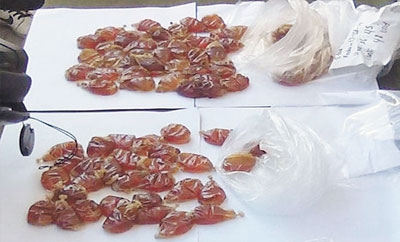Officials in Bolivia say drug mules are increasingly ingesting liquid cocaine in an effort to avoid detection during transport, a tactic that has the potential to grow in use as drug traffickers continually search for lower-risk and cost-effective ways to get their product to the market undetected.
Alexander Rojas, the director of Bolivia’s anti-narcotics police unit (FELCN), said ingesting liquid cocaine “is the new form of moving cocaine chlorhydrate,” reported La Razon. He said the method was usually used to move drugs to Chile, where the cocaine multiplied in cost compared with Bolivian prices, from around $3,000 to up to $15,000.
SEE ALSO: Coverage of Bolivia
Using latex to transport cocaine in liquid form makes it more difficult to detect, according to Rojas. The color of the liquid and the transparency of the latex are not as visible as capsules to x-ray equipment and airport security.
Transporting liquid cocaine in latex, instead of in powder capsules, also makes it possible to swallow more of the drug in fewer packages. “Each person can carry approximately one kilo or a little more,” said Rojas. However, this also poses a greater risk of death if the latex were to burst, reported La Razon.
In 2013, at least ten people were arrested for transporting liquid cocaine in Bolivia. Two more almost died recently while trying to take drugs to Chile using this method. Rojas believes the transport of liquid cocaine in latex by mules out of Cochabamba has become common since 2011.
InSight Crime Analysis
Moving cocaine in liquid form is nothing new — this has also become a popular way of moving large drug shipments, as it is easier to disguise. This soluble form can be packaged and shipped in inventive ways to avoid detection, such as absorbing the drug in clothing or freezing it.
Ingesting liquid cocaine to cheat airport security and x-ray machines, however, appears to be a relatively new development in cocaine trafficking methods.
Chile has become a major destination for mules trafficking drugs from Bolivia, though earlier reports have centered on cocaine moved by bus. Mules can be paid as little of $1,000 in Bolivia to swallow around a kilo of cocaine, making them a relatively cost-effective transport method.
Using mules to transport liquid cocaine could provide traffickers with a way to increasingly rely on aerial trafficking — which is much more efficient than land trafficking and carries a lower risk of detection.
While it remains small scale at the moment, the ability of this tactic to elude detection could lead to its becoming a region wide phenomenon.

